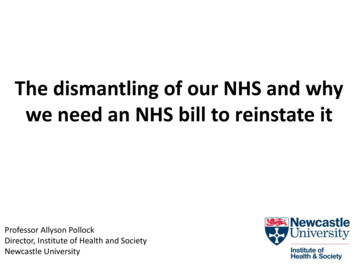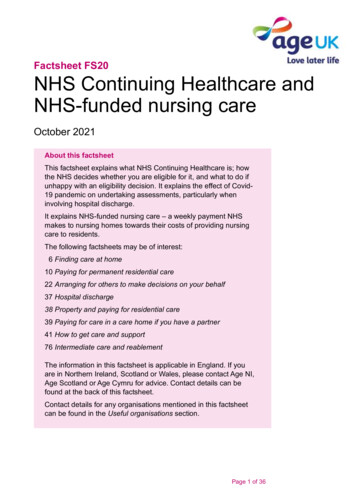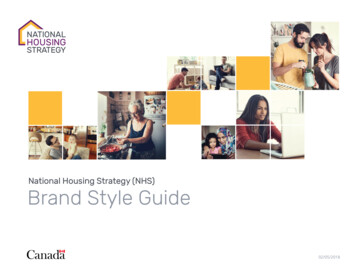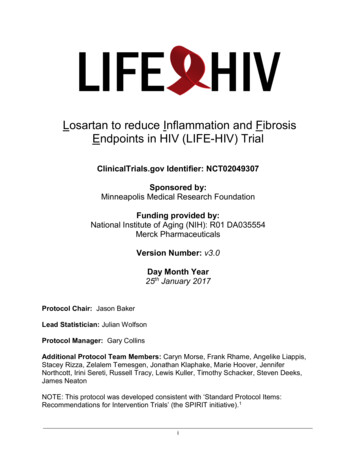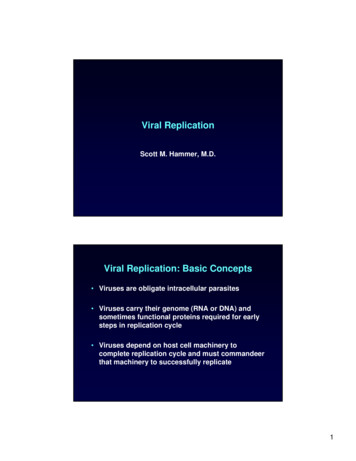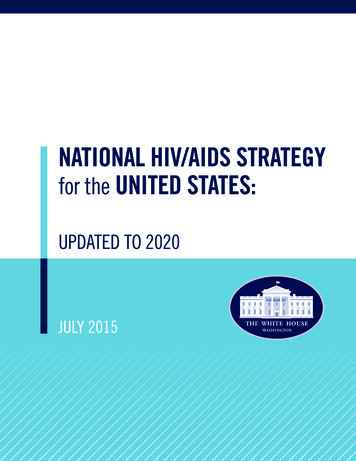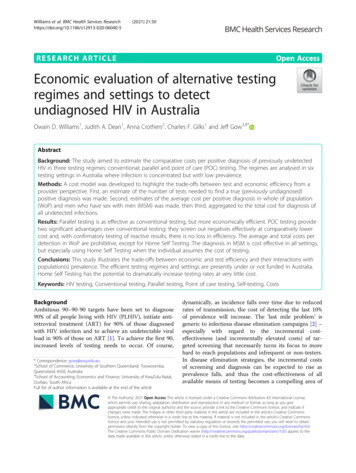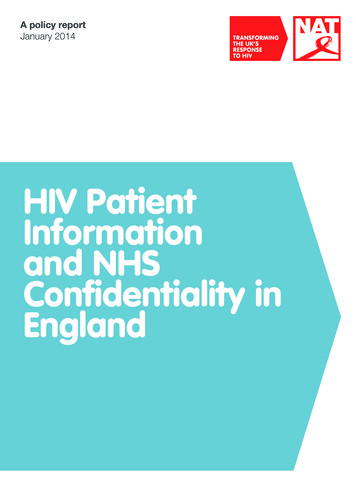
Transcription
A policy reportJanuary 2014HIV PatientInformationand NHSConfidentiality inEngland
HIV Patient Information and NHS Confidentiality NATCONTENTSAINTRODUCTION3Background3Methodology 4BPATIENT INFORMATION AND THE NHS - THE BASIC ARCHITECTUREThe requirement to keep accurate recordsPatients’ rights to access their health recordsConfidentiality of personal medical information - the legal and policy basisConfidentiality of personal medical information - some key conceptsThird party requests to GPs - insurance, employers, benefits and solicitorsJustification for non-consensual disclosure667891213CHIV PATIENT INFORMATION AND NHS CONFIDENTIALITYThe NAT online survey - characteristics of respondentsThe HIV clinic patient recordThe NHS number and the patient recordThe continuing separation of GU clinic records, and the patient with HIVSharing information on HIV status to support high quality careImplied consentRefusal of consent to share information in direct careAdministrative staff‘No surprises’ - informing patients about how their personal confidentialinformation is used and sharedWider issues of conduct in healthcare - breaches of confidentialityWider issues of conduct - stigma and discriminationThe Summary Care RecordLocal clinical audit1414161820222428293236394243D‘SECONDARY USES’ - SURVEILLANCE, RESEARCH, AUDITS ANDCOMMISSIONINGKey principles for secondary uses of personal informationSection 251 powersSome examples of secondary usesRight to refuse consent to secondary usesThe NHS number and secondary uses444446475153ETO SUMMARISE 56FCONCLUSIONS AND RECOMMENDATIONS57GANNEX61ACKNOWLEDGEMENTS 2
HIV Patient Information and NHS Confidentiality NATA IntroductionWe are living through a time of immense change in how healthcare is organised and delivered.This is as true for how our medical information is handled as it is for commissioning arrangementsand healthcare delivery. There is a renewed emphasis on the effective sharing of our medicalinformation between different professionals responsible for our care, to ensure the care is asintegrated and as safe as possible. There is also great interest in the potential our medicalinformation holds for researchers, epidemiologists and commissioners. It can help them betterunderstand health issues affecting the whole nation and particular parts of the country, the qualityof health outcomes and care pathways, the impacts of specific drugs and the spread of disease.The increasing computerisation of records and the possibilities of information technology only addfurther momentum to this agenda.At the same time as this emphasis on data sharing in healthcare, there is an equally strong focuson confidentiality within the NHS. There has always been a particular attention to confidentialitywithin sexual health services, but in recent years the wider NHS has also developed strongconfidentiality systems, rules, principles and protocols, bolstered by legislation (for example theData Protection Act 1998 and the Human Rights Act 1998).How do we maintain a balance between the importance of sharing medical information and theimportance of keeping it confidential? HIV status brings this question into particularly sharp relief.HIV remains unfortunately a stigmatised condition and one which understandably many peopleliving with HIV are very wary and sensitive about sharing or disclosing widely. But with effectivetreatment now available people with HIV can live a normal lifespan and, especially as they getolder, will need to access a wide range of services within the NHS, both GPs and hospitalspecialists, just like everyone else. Their HIV status and the medication they are taking will berelevant information which needs to be shared.BackgroundA number of factors prompted NAT to undertake this project looking at ‘HIV Patient Informationand NHS Confidentiality’. There was of course the context described above which suggesteda fresh look was needed at the issue. The Health and Social Care Act 2012 introduced newarrangements around the handling of personal confidential information in the NHS, and inparticular the establishment of a new body, the Health and Social Care Information Centre(HSCIC). Also in 2012 the Government asked Dame Fiona Caldicott to chair an InformationGovernance Review, which looked at all aspects of handling confidential information in healthand social care, which reported in March 2013. Another outcome of the Health and SocialCare Act was that it brought an end to ‘the VD Regulations’, as they were known. TheseRegulations placed particularly stringent confidentiality requirements on sexual health services.In their absence, what, if any, additional protections should there be in the NHS for sexual healthinformation?One further key motive to investigate this issue was the consultation on the draft BHIVA (British 3
HIV Patient Information and NHS Confidentiality NATHIV Association) Standards of Care for People Living with HIV. In the consultation document, inrelation to Standard 12 on ‘Information for public health surveillance, commissioning, audit andresearch’ was a proposal for the routine request to patients by HIV clinics for the use of their NHSnumber for the linking of data for secondary purposes such as research and commissioning.NAT raised concerns about the inclusion of this recommendation, not because we werenecessarily opposed to the idea but because there was little knowledge amongst people withHIV and HIV organisations, including NAT, as to what the implications might be of the use of theNHS number in this way. We proposed instead a further and separate process to look into theissue, and to feed into any further revisions of the Standards in due course. In the final publishedMethodologyNAT’s project on ‘HIV Patient Information and NHS Confidentiality’ has been supported by BHIVA,both with a funding contribution and with a small group of HIV clinicians and researchers beingbrought together to advise on the project (see Annex). There are two outputs to emerge fromthe project - this policy report which reviews the relevant issues and makes recommendations,and also a resource for people living with HIV, endorsed by BHIVA, explaining how their personalconfidential information is handled within the NHS.The development of the policy report involved desk-based research and discussions with a widerange of healthcare professionals and experts. An initial briefing paper was drafted which formedthe basis of discussions at an expert roundtable held in July 2013 (for participants see Annex).The roundtable discussion clarified some of the key themes and conclusions of this report. Italso provided useful background for the next stage of the project, which was to gather views andexperiences from people living with HIV.An online survey was open for about four weeks for people living with HIV in England to completeand there were 245 respondents. We do not of course claim that survey respondents werenecessarily representative of all people with HIV in their understanding and opinions - it is likelythat the survey over-sampled people who had pre-existing views and concerns. Nevertheless it isprecisely such concerns which an appropriate confidentiality system needs to address. Both thequantitative and qualitative data from the survey provide a useful insight into the range of opinionand experience amongst people living with HIV. 4
HIV Patient Information and NHS Confidentiality NATWe also held two consultation meetings with people living with HIV, one in partnership withGeorge House Trust in Manchester and one in partnership with Positively UK in London. Intotal 27 people attended and there was diversity in gender, ethnicity, sexuality and recency ofdiagnosis. In an attempt to compensate for the inevitable bias of the online survey’s sampling,volunteers were invited to join the consultation meetings simply to assist NAT in a policy project,without initial information that it was about confidentiality issues.There are a number of important issues around ‘HIV Patient Information and NHS Confidentiality’which were beyond the scope of this particular project. This report looks only at England. Thehandling of patient information can only be understood within the specific legal and healthcarearrangements of a national system. The system in England is significantly different in anumber of respects from those in Scotland, Wales and Northern Ireland. It would have beentoo complicated to attempt to cover all four different national systems in one project. We do,however, hope that key conclusions from this project can be applied more widely in the UK andwe will look for opportunities to do so in the coming months.There is now a welcome concern to improve integration of health and social care services.Both the Information Governance Review and the statutory functions of the HSCIC cover bothhealth and social care. We do not, however, in this project look at HIV information and socialcare services. We know of significant concerns amongst many people with HIV about howtheir personal information is handled within social care1 and do not believe standards are as yetcomparable to those in the NHS. A separate and further piece of work is needed to look in detailat the handling of personal confidential medical information by social care services.We do not in this report look at issues relating to carer or family access to someone’s personalconfidential information, or to issues relating to information about someone deceased.This project only looks at personal confidential information on adults living with HIV. There areadditional confidentiality issues relating to children and younger people which we could not in thetime available bring within the scope of this project. Again, the issue is an important one and wetrust further work will be done on it in the future.See NAT ‘The impact of social care support forpeople living with HIV: the results of NAT’s snapshotsurvey of healthcare professionals’ June 2011 pdf1 5
HIV Patient Information and NHS Confidentiality NATB Patient Information And The NHS -The Basic ArchitectureIn this section we will describe some of the key elements in the ‘architecture’ of NHSconfidentiality and data handling provisions. It is not meant to be an exhaustive account andreaders are recommended to go to the website of the Health and Social Care Information Centre(HSCIC) for comprehensive and up-to-date information on these issues atwww.hscic.gov.uk. There are a wide range of relevant documents around NHS confidentiality butthe HSCIC is aiming in its recent and forthcoming key confidentiality documents to bring togetherall relevant information and be the first port of call for those who need to know how personalconfidential information is handled in the NHS. For that reason, we have thought it best as far aspossible to refer to HSCIC documents in this report.The requirement to keep accurate recordsAll healthcare professionals have a duty to keep accurate medical records. For example, in‘Good Medical Practice’ the General Medical Council tells doctors that ‘Documents you make(including clinical records) to formally record your work must be clear, accurate and legible’.Clinical records should include:relevant clinical findingsthe decisions made and actions agreed, and who is making the decisions and agreeingthe actionsthe information given to patientsany drugs prescribed or other investigation or treatmentwho is making the record and when.2The HSCIC states that ‘A key part of the trust relationship is ensuring that the care record is complete, accurate and fit for purpose. Information is not safe if it is not accurate. It is theresponsibility of each member of the team to ensure this’.3This is an important principle to understand in relation to the recording of HIV status, treatmentand medication in patient records. What is recorded in patient records is not for the patient todictate or determine. The healthcare worker has professional and ethical responsibilities to recordrelevant information fully and accurately, above all for the benefit of the patient, but also to satisfyany possible further review that they acted appropriately in their clinical care.2GMC ‘Good Medical Practice’ 2013 paras.19-21HSCIC ‘A guide to confidentiality in health and SocialCare’ 2013 p.11. See also NHS ‘Confidentiality: NHSCode of Practice’ Nov 2003 Annex A3 6
HIV Patient Information and NHS Confidentiality NATPatients’ right to access their health recordsThe patient does, however, have a legal right to see their own healthcare records. This right hasas its current legal basis the Data Protection Act 1998 (Part II Rights of data subjects and others)and is summarised in the NHS Constitution - ‘You have the right of access to your own carerecords and to have any factual inaccuracies corrected’.4 So the patient can see and challengerecords if they are thought to be inaccurate. Speaking to healthcare workers it also becameclear that if a patient objects to the wording of a particular entry i.e. how something is phrasedor put across, especially in relation to a sensitive condition such as HIV, most healthcare workerswould make an effort to agree wording which whilst accurate was also something the patient wascomfortable with.The Information Governance Review called for less bureaucratic processes to facilitate access toone’s own records, and an end to the charging of fees to see one’s records. The Governmenthas committed to provide patients with electronic access to their GP records by 2015, followedsoon after by other healthcare records.5 In its response to the Information Governance Review,the Government re-stated this commitment.6Electronic patient records allow sight not only of the content of patient records but also of theidentities of all who have accessed them, because access for NHS staff to patient records is bya combination of personal swipecard and password. (Of course this would not include peoplewho ‘borrow’ someone else’s swipecard and password to access a record, or where a screen isnot closed down or shielded properly and others see its contents - both of which are a breachof confidentiality rules). The Information Governance Review recommended that details shouldbe made available to the patient of ‘anyone and everyone who has accessed an individual’selectronic personal confidential information’.7 The Government in its response to the reviewagreed with the general need for patients to have confidence in the safety and security of theirrecords but fell short of agreeing with this specific recommendation, stating that an ‘optionsanalysis’ would be commissioned to determine the best approach by April 2014.8Looking forward, there is increasing interest in the use of personal health records ‘owned’ bypatients themselves.4NHS Constitution 2013See Information Governance Review March 2013Chapter 2 ‘People’s right to access information aboutthemselves’5‘Information: To Share or not to Share - Governmentresponse to the Caldicott Review’ Sept 2013 para 2.367Information Governance Review March 2013 section 2.4‘Information: To Share or not to Share - Governmentresponse to the Caldicott Review’ Sept 2013 para 2.58 7
HIV Patient Information and NHS Confidentiality NATConfidentiality of personal medical information - the legal and policy basisThere is a long-standing common law9 duty of confidentiality in relation to personal medicalinformation, which can be summarised as follows: that information provided in confidenceshould be treated as such and not divulged to third parties. This fundamental principle has beenextended and deepened through statute law, through regulatory requirements and through NHSpolicy and practice.In addition to the common law duty itself, three key benchmarks are:the Data Protection Act 1998, including the Data Protection Principles, as found inSchedule 1 of the Act, further explained in a Guide from the Information Commissioner’sOffice;10the Caldicott Principles, as set out in 1997 in the first Caldicott Review11 and then addedto with a further final principle as a result of the more recent Information GovernanceReview;12and the five Confidentiality Rules set out by the HSCIC in ‘A guide to confidentiality inhealth and social care.’13 The HSCIC is also currently preparing a Code onConfidentiality. Both the published HSCIC Guide and the forthcoming Code have legalforce in that the Health and Social Care Act 2012 requires health and social care bodiesto have regard to the Guide and the Code.The Caldicott Principles have since 1997 been an important driver of increased NHS sensitivity toconfidentiality considerations. Every NHS organisation, including individual GP practices, musthave a Caldicott Guardian or Caldicott Lead to ensure compliance with the Caldicott Principles.Healthcare professionals are required to uphold certain standards of confidentiality as part of theirregulatory requirements. The HSCIC provides a full list of such regulatory bodies, but examplesinclude the General Medical Council for doctors and the Nursing and Midwifery Council for nursesand midwives.14 These professional confidentiality standards are consistent with the requirementsof the NHS and the HSCIC, and may in some instances make additional confidentialityrequirements. If these standards are not met the healthcare professional risks being disciplinedand struck off their professional register. This would mean they can no longer practice. Nonregulated administrative and managerial staff in healthcare bodies have equivalent confidentialityobligations as part of their NHS contracts of employment (and indeed contracts for regulatedNHS staff also contain these confidentiality requirements).Other important components of NHS confidentiality requirements to mention briefly include - theHuman Rights Act 1998, and Article 8 of the European Convention of Human Rights. Both theAct and the Convention provide a qualified right to a private life; administrative law which requirespublic bodies to handle information in accordance with the purpose for which they have beencreated; and the NHS Constitution, revised in 2013, which contains rights and pledges relatingto ‘Respect, consent and confidentiality’, and which all NHS bodies are required by law to takeaccount of.15 8
HIV Patient Information and NHS Confidentiality NATConfidentiality of personal medical information - some key conceptsIn this section we highlight some aspects of confidentiality which are particularly relevant tothe HIV-specific issues we will go on to address later in this report. Readers are referred tothe websites of the HSCIC and the Information Commissioner’s Office for more detailed andcomprehensive information.Use confidential information only when there is a specific and lawful reasonto do soThe first Caldicott Principle is ‘Justify the purpose’ - any use of confidential information ‘shouldbe clearly defined, scrutinised and documented’. The second Data Protection Principle of the1998 Act states that ‘Personal data shall be obtained only for one or more specified and lawfulpurposes, and shall not be further processed in any manner incompatible with that purpose orpurposes’.Use confidential information only when it is necessary to do soOnly use confidential information if the purpose cannot be achieved by anonymising oraggregating the information so as to hide the identity of the individual concerned. The secondCaldicott Principle states ‘Don’t use personal confidential data unless it is absolutely necessary’and the third Principle states ‘Use the minimum necessary personal confidential data. The fourthprinciple states ‘Access to personal confidential data should be on a strict need-to-know basis’.All three Principles underline the absolute requirement of necessity for any use and sharing of, oraccess to, confidential health information.Consent of the patient is necessary for the use and handling of theirpersonal confidential information – explicit consent or implied consentWhen a patient shares their personal health information with a healthcare professional this isdone under an expectation that the information is kept confidential and not shared with anyoneelse. Of course this duty of confidentiality can be overridden when the patient consents to thehealthcare professional sharing that information with others. 9
HIV Patient Information and NHS Confidentiality NATThere are two sorts of consent - explicit consent and implied consent. The HSCIC definesconsent as ‘’the approval or agreement for something to happen after consideration’.16 They goon to state, ‘Explicit consent is unmistakeable. It can be given in writing or verbally, or conveyedthrough another form of communication such as signing’.The HSCIC explains that ‘Implied consent is applicable only within the context of direct careof individuals. It refers to instances where the consent of the individual patient can be impliedwithout having to make any positive action, such as giving their verbal agreement for a specificaspect of sharing information to proceed. Examples of the use of implied consent includedoctors and nurses sharing personal confidential information data during handovers withoutasking for the patient’s consent’.17The concept of implied consent has proved to be an important one when we discussedconfidentiality issues with people living with HIV. It is assumed that the patient is happy for theirrelevant personal confidential information to be shared amongst those who are part of the teamor teams providing the patient with direct care. This includes both sharing within a care team andalso between care teams (for example, when a referral is made).Sharing with the direct care teamImplied consent is assumed for the sharing of personal confidential information amongst thosein the team providing direct care to the patient. This is not only sharing information within aparticular team (e.g in the HIV clinic) but also across different teams, for example when a referralis made from an HIV clinic or GP to a hospital specialty. Administrative staff who are members ofa direct care team are amongst those for whom implied consent is assumed (see further below).The rationale for this approach is neatly summed up by the HSCIC, ‘Confidential informationabout an individual must not leak outside the care team, but it must be shared within it in order toprovide a seamless, integrated service’.Right to refuse consent to sharing of information with those providing careWhilst implied consent is assumed for sharing of personal confidential information within thedirect care team, individuals should generally ‘be informed about who will see their confidentialinformation. Without such advice they may not be aware of the wide range of staff who arepart of the direct care team’.18 The individual can explicitly refuse consent to the sharing oftheir information with someone providing them with direct care and this decision ‘should beHSCIC ‘A guide to confidentiality in health and socialcare: references’ September 2013 Section 2 p.71617ibid. pp.7-8HSCIC ‘A guide to confidentiality in health and socialcare’ 2013 p.1318 10
HIV Patient Information and NHS Confidentiality NATrespected’.19 In some instances staff may believe that the item of confidential information isessential for the safe provision of direct care. In such cases ‘staff should explain that failure todisclose that information may compromise the individual’s care’. The HSCIC does go on to saythat ‘In some exceptional cases, an individual’s request not to share confidential informationwithin the care team may effectively mean that care cannot be provided. The individual’s choiceto refuse to share confidential information about them in this way is tantamount to refusal ofcare’.20Patients should know how their personal confidential information is usedYou cannot consent to the use of information you know nothing about. The HSCIC Guide onconfidentiality provides a helpful and extended definition of consent:‘Consent is the approval or agreement for something to happen after consideration. Forconsent to be legally valid, the individual must be informed, must have the capacity to make thedecision in question and must give consent voluntarily. This means individuals should know andunderstand how their information is to be used and shared (there should be ‘no surprises’) andthey should understand the implications of their decision, particularly where refusing to allowinformation to be shared is likely to affect the care they receive. This applies to both explicit andimplied consent.’21It states:‘Unless those patients and service users understand how confidential information about themwill be used and who will get to see it, they cannot be considered to be fully informed when theyconsent to treatment and care.’ 2219ibid. p.1320ibid. p.14HSCIC ‘A guide to confidentiality in health and socialcare: references’ September 2013 Section 221HSCIC ‘A guide to confidentiality in health and socialcare’ 2013 pp. 7-8 21HSCIC ‘A guide to confidentialityin health and social care: references’ September 2013Section 222 11
HIV Patient Information and NHS Confidentiality NATThird party requests to GPs - insurance, employers, benefits and solicitorsInsurance reports or reports to employers are the main outflow of information from GPs to nonNHS third parties.23 An insurance company will send to the GP a signed consent form fromthe patient agreeing to the release of the information (the GP practice should have a record ofthe patient’s signature). The request for information will also say whether the patient wishes tosee the information before it is sent out (we were told this is very rare) plus further guidance (forexample not including negative HIV tests). Similarly for employers’ requests for information, it isexpected that the GP will satisfy themselves that the patient understands what is involved in thedisclosure, has consented to the disclosure and will offer to show the patient, or give them acopy of, any report they write about them.24If a patient refuses consent the information should not be sent (apart from where disclosure isrequired by law or can be justified in the public interest - see below).Whilst in the past the doctor would write a letter and include relevant information, the adventof the summary record means it is now often easier to send that - which may well meanthat processes have become laxer and more information than is strictly necessary may becommunicated. Issues around the sending of ‘whole records’ are picked up in the InformationGovernance Review. Guidance from the General Medical Council makes clear that onlyinformation relevant to the request should be disclosed ‘so you should not usually disclosethe whole record’.25 Exceptions to this are some benefits claims and litigation where solicitorsmay sometimes ask for, and have the right to, the whole record of someone in, for example,negligence or compensation claims.Just as the GP should not include irrelevant information, she or he should not leave outinformation which is relevant.See ‘Medical Information and Insurance’ JointGuidelines from the British Medical Association andthe Association of British Insurers March 2010, and‘Confidentiality: disclosing information for insurance,employment and similar purposes’ General MedicalCouncil Sept 200923General Medical Council ‘Confidentiality: disclosing informationfor insurance, employment and similar purposes’ September20092425ibid. 12
HIV Patient Information and NHS Confidentiality NATJustification for non-consensual disclosureThere are circumstances where disclosure of personal confidential information is required or ispermissible even without patient consent. This may involve a legal obligation to disclose, forexample in response to a court order or on the basis of legislation such as that requiring thenotification of certain infectious diseases (HIV is not a statutorily notifiable infectious disease).It can also involve a permission to disclose without consent when the clinician believes there isan overriding public interest to do so which trumps the common law duty of confidentiality. TheGeneral Medical Council provides detailed advice in this area.26 Such cases are expected to beexceptional and in most instances there should still first be an attempt to secure patient consent.Common public interest considerations include the prevention, detection or prosecution ofserious crime, or to prevent the spread or reduce risk from serious communicable disease.For people living with HIV it is this latter context which may be most relevant since guidancedoes allow the clinician to disclose, without patient consent, to a current or former sexualpartner of someone diagnosed with HIV that they may be at risk.27 It is important to note this ispermissive, not mandatory - in other words the clinician can override consent but is not obligedto do so. It is possible that the clinician deems the risk of harm to the patient, or to confidencein the confidentiality of the clinic, to be more significant than concerns about sexual partners. Itwould also be expected that such non-consensual partner notification would be a last resort afterextended and intensive efforts to secure the patient’s consent.General Medical Council ‘Confidentiality’ 2009paras.36-5626General Medical Council ‘Confidentiality: disclosinginformation about serious communicable diseases’September 200927 13
HIV Patient Information and NHS Confidentiality NAT 14C HIV Patient Information and NHSConfidentialityIn this section we discuss some of the main issues which have emerged in discussion withexperts, both one-to-one and at our roundtable, and with people living with HIV in our twoconsultation meetings and via our online survey.The NAT O
B PATIENT INFORMATION AND THE NHS - THE BASIC ARCHITECTURE The requirement to keep accurate records Patients' rights to access their health records . This is an important principle to understand in relation to the recording of HIV status, treatment and medication in patient records. What is recorded in patient records is not for the patient to

